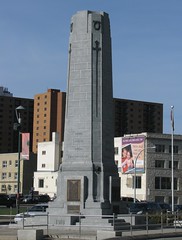© 2011, Christian Cassidy
Place: Winnipeg Cenotaph
Location: Memorial Boulevard
Artist: Gilbert Parfitt
Dedicated: November 7, 1928
Cost: $25,000
By this time, it was felt that the city needed to create a new, permanent cenotaph. A number of groups were in various stages of advocating for, or even planning to build, their own memorials. To get out in front of them the city created a Cenotaph Committee chaired by former Mayor R. D. Waugh.
A number of sites were considered, ranging from another location near Portage and Main to the city hall grounds. The committee eventually settled on a site on the newly created Mall that ran perpendicular to Portage from the new Hudson's Bay store to the Legislature.
With a location selected it was time to find a design.
The cenotaph committee decided to hold a national design competition and received 48 proposals from across the country. It chose number 33, a 21 foot tall work by noted Toronto artist Emanuel Hahn.
The fact that Hahn was German born, (he came to Canada as a child and was a naturalized citizen), did not sit well with some groups including the city's Board of Trade which led a campaign to have the decision reversed. A letter from the board to the Free Press published on February 17, 1926 summed up their position:
“The purpose of the cenotaph is founded in patriotism and sentiment. It is to be a memorial to our glorious dead – a shrine…. The Board having received ample evidence that a memorial, the work of a German born, would under the circumstance attending the late war be unacceptable to many of our citizens who had suffered most by the war.”
The battle over the choice of design dragged on for months. In the end, it was decided to scrap the first design competition and hold a new one. Hahn was sent a $500 cheque for the winning entry, (despite the rejection went on to have a long and distinguished career.)
The second national design competition held more surprises.
The winning entry was by Elizabeth Wyn-Wood of Toronto and raised some eyebrows. It depicted a loin-clothed man holding a sword which some felt lacked the solemnity required for a cenotaph.
As the debate over the selection raged on, it came to light that Wyn-Wood was the wife of Emanuel Hahn, the winner of the first contest. Some were suspicious that Hahn himself had created the design and turned it in under her name, though Wyn-Wood was a sculptor in her own right.
Parfitt, Dec 5 1927, Winnipeg Free Press
The selection sub-committee again backed down on their decision and Wyn-Wood was paid off for her winning design. It also skipped over the runner-up, A. H. Eadie of Toronto, and went with the third place winner, Gilbert Parfitt of Winnipeg.
No detailed explanation was given as to why the runner up was rejected, though there was a growing sentiment that the committee should find a local artists that would use local materials to avoid any further surprises.

Parfitt was an architect who worked for the province and would later become the province's chief architect. His design was much simpler then previous winners consisting of a column of stone with little decoration aside from a sword, cross, and small lion heads all in bronze.
Construction began in December 1927 and there were no surprises or controversy. The Winnipeg cenotaph was officially dedicated on November 7, 1928, just in time for Remembrance Day.
Related:








No comments:
Post a Comment